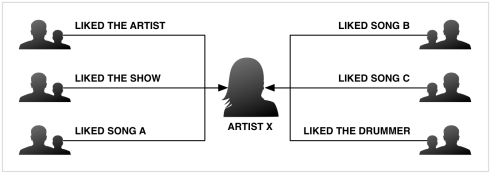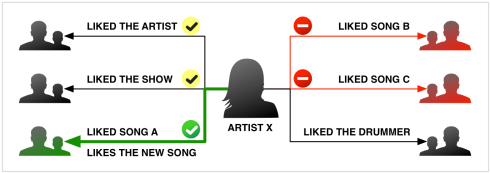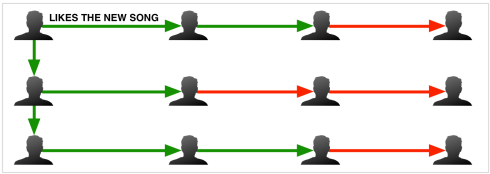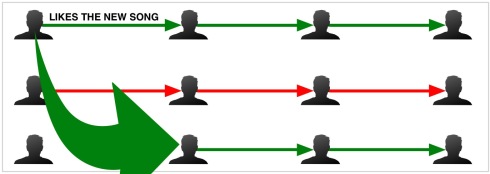We like to think of the web as one big, endless, interconnected net of relationship fibers where a tug on a single fiber causes random ripples and pulls all across the entire net; that somehow a path will emerge, narrow as it may be, where a ripple can travel from one corner of the net to the other; and that if you - the music marketer - could only simultaneously pull enough social strings, your message would be riding on a magic carpet instead of a thread.
However If the ripple effect worked on the social web, then how come artists with hundreds of thousands of followers and many thousands of fans have so much trouble creating sustainable engagement where the ripples are broad enough (to live upon) or at least endless? Songs often don’t find their intended audiences, seats go unfilled, videos don’t go viral, and messages get quickly swallowed in a sea of social noise. It happens every day; it happens to almost every artist on earth; and the exceptions are rarer than you think.
Obviously people connect together on the web and echo each other’s messages for a variety of social reasons (roots, relationships and economic requirements). However I’ll stipulate that music preferences are not the (strong) bonds that bind us all together, and that furthermore, individual music preferences function as much as ripple blockers as ripple senders.
Using fictitious artist X with ten thousand followers as an example, consider what happens when artist X releases a new single via Facebook and Twitter. See the graphic below. Originally, fans connected with artist X for a variety of reasons. Some liked X (the person); some liked the live shows; some liked song A, or song B, or song C; and some simply liked the drummer. None of the likes have to be mutually exclusive, as there are some fans that like everything…including the drummer.
The new song from artist X has a sonic, emotional and lyrical profile that is very similar to song A (released two years prior). However (fictitiously speaking), the new song doesn’t really resonate with those that liked songs B and C in the past; only those that liked song A are willing to move the ‘new song’ message forward to their friends and followers; albeit all this happens along a spectrum.
Moving along, the new song with it’s own profile, travels down social pathways to places where music preference profiles of interconnected humans overlap and intersect.
Finally the song ceases to travel further, full stopped and roadblocked by disinterested listeners, as this is the place where it has run out of interconnected overlaps. However that doesn’t mean that the song has nowhere else to go. What’s needed next are bridges that jump over roadblocks to new pathways where the song’s profile keys into the music preferences profiles of other potential new fans.
Highly-targeted, music-connected advertising is one bridge that artists or labels as advertisers can use to jump into new pathways where the profiles of artists and songs are far more likely to match the music preference profiles of prospective fans. Music-connected advertising enables advertisers to target (in a geographic area) genres, keywords, sites and similar artists (who have fans that are likely to also become your fans). However be prepared to wait a while for new fans to open pathways to friends and followers with overlapping music preference profiles (a.k.a measurable engagement), as the time lag between a download and a proclamation of affection (and subsequent ripples) can often take months.
All forms of advertising, including Facebook advertising, as well as strategic PR, serve as bridges to disconnected fan groups. The key to successful ‘bridging’ in the music industry is to know for sure who your target audience is, as there is hardly enough return on what we do to be able to afford more than one or two near misses. On top of having a great song and engaging (ad) creative, precision targeting and A/B testing (measure twice cut once) are essential to successful advertising.
Unfortunately artists mistake social media for outbound marketing, or they simply use it because it’s free and everyone tells them they must. Social engagement (by an artist) has its uses, but in my humble opinion it’s something you do for fans and not to acquire them. Moreover if you solely rely upon it, you will never know if you or your song could have jumped the rails to something greater. If you don’t build bridges, you run the risk of stranding yourself on the Facebook and Twitter islands you have arduously constructed for yourself.